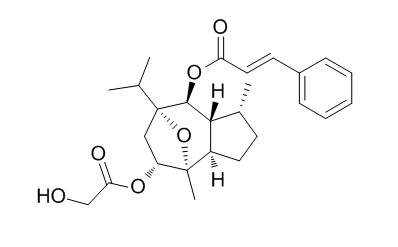Englerin A
Englerin A, a selective inhibitor of renal cancer cell growth, it is a therapeutic lead for the treatment of renal cell carcinoma. Englerin A induces an acute inflammatory response and reveals lipid metabolism and ER stress as targetable vulnerabilities in renal cell carcinoma.
Inquire / Order:
manager@chemfaces.com
Technical Inquiries:
service@chemfaces.com
Tel:
+86-27-84237783
Fax:
+86-27-84254680
Address:
1 Building, No. 83, CheCheng Rd., Wuhan Economic and Technological Development Zone, Wuhan, Hubei 430056, PRC
Providing storage is as stated on the product vial and the vial is kept tightly sealed, the product can be stored for up to
24 months(2-8C).
Wherever possible, you should prepare and use solutions on the same day. However, if you need to make up stock solutions in advance, we recommend that you store the solution as aliquots in tightly sealed vials at -20C. Generally, these will be useable for up to two weeks. Before use, and prior to opening the vial we recommend that you allow your product to equilibrate to room temperature for at least 1 hour.
Need more advice on solubility, usage and handling? Please email to: service@chemfaces.com
The packaging of the product may have turned upside down during transportation, resulting in the natural compounds adhering to the neck or cap of the vial. take the vial out of its packaging and gently shake to let the compounds fall to the bottom of the vial. for liquid products, centrifuge at 200-500 RPM to gather the liquid at the bottom of the vial. try to avoid loss or contamination during handling.
Food Chem.2019, 279:80-87
Korean J. Food Preserv.2023, 30(4):663-668.
National Academy Science Letters2023, s40009.
Foods.2024, 13(23):3861.
J Sep Sci.2023, 46(16):e2300160.
Acta Biochim Pol.2015, 62(2):253-8
J of Food Quality2020, 8851285.
Mol Cell.2017, 68(4):673-685
Chinese Journal of Hospital Pharmacy2020, 40(7)
Biomolecules2021, 11(10),1513.
Related and Featured Products
PLOS ONE, 2017, 12(3):e0172632.
Englerin A induces an acute inflammatory response and reveals lipid metabolism and ER stress as targetable vulnerabilities in renal cell carcinoma.[Reference:
WebLink]
Renal cell carcinoma (RCC) is among the top ten most common forms of cancer and is the most common malignancy of the kidney. Clear cell renal carcinoma (cc-RCC), the most common type of RCC, is one of the most refractory cancers with an incidence that is on the rise. Screening of plant extracts in search of new anti-cancer agents resulted in the discovery of Englerin A, a guaiane sesquiterpene with potent cytotoxicity against renal cancer cells and a small subset of other cancer cells. Though a few cellular targets have been identified for Englerin A, it is still not clear what mechanisms account for the cytotoxicity of Englerin A in RCC, which occurs at concentrations well below those used to engage the targets previously identified.
METHODS AND RESULTS:
Unlike any prior study, the current study used a systems biology approach to explore the mechanism(s) of action of Englerin A. Metabolomics analyses indicated that Englerin A profoundly altered lipid metabolism by 24 h in cc-RCC cell lines and generated significant levels of ceramides that were highly toxic to these cells. Microarray analyses determined that Englerin A induced ER stress signaling and an acute inflammatory response, which was confirmed by quantitative PCR and Western Blot analyses. Additionally, fluorescence confocal microscopy revealed that Englerin A at 25 nM disrupted the morphology of the ER confirming the deleterious effect of Englerin A on the ER.
CONCLUSIONS:
Collectively, our findings suggest that cc-RCC is highly sensitive to disruptions in lipid metabolism and ER stress and that these vulnerabilities can be targeted for the treatment of cc-RCC and possibly other lipid storing cancers. Furthermore, our results suggest that ceramides may be a mediator of some of the actions of Englerin A. Lastly, the acute inflammatory response induced by Englerin A may mediate anti-tumor immunity.
Journal of Experimental & Clinical Cancer Research volume 32, Article number: 57 (2013)
Renal cancer-selective Englerin A induces multiple mechanisms of cell death and autophagy.[Reference:
WebLink]
Renal cell carcinoma (RCC), the most common malignancy of the kidney, is refractory to standard therapy and has an incidence that continues to rise. Screening of plant extracts in search of new agents to treat RCC resulted in the discovery of Englerin A (EA), a natural product exhibiting potent selective cytotoxicity against renal cancer cells. Despite the establishment of synthetic routes to the synthesis of EA, very little is known about its mechanism of action.
METHODS AND RESULTS:
The results of the current study demonstrate for the first time that EA induces apoptosis in A498 renal cancer cells in addition to necrosis. The induction of apoptosis by EA required at least 24 h and was caspase independent. In addition, EA induced increased levels of autophagic vesicles in A498 cells which could be inhibited by nonessential amino acids (NEAA), known inhibitors of autophagy.
Interestingly, inhibition of autophagy by NEAA did not diminish cell death suggesting that autophagy is not a cell death mechanism and likely represents a cell survival mechanism which ultimately fails.
Apart from cell death, our results demonstrated that cells treated with EA accumulated in the G2 phase of the cell cycle indicating a block in G2/M transition. Moreover, our results determined that EA inhibited the activation of both AKT and ERK, kinases which are activated in cancer and implicated in unrestricted cell proliferation and induction of autophagy. The phosphorylation status of the cellular energy sensor, AMPK, appeared unaffected by EA.
CONCLUSIONS:
The high renal cancer selectivity of EA combined with its ability to induce multiple mechanisms of cell death while inhibiting pathways driving cell proliferation, suggest that EA is a highly unique agent with great potential as a therapeutic lead for the treatment of RCC.



